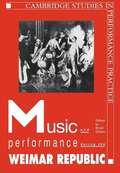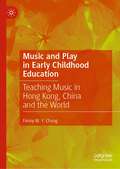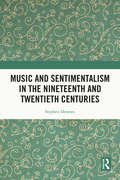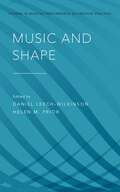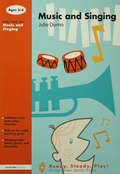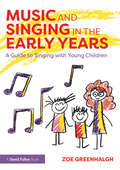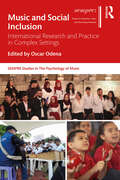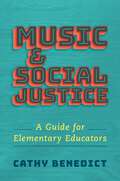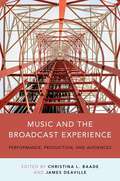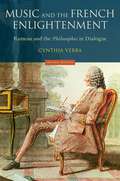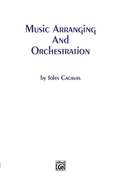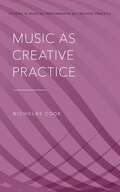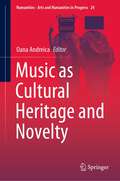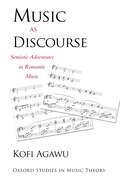- Table View
- List View
Music And Performance During The Weimar Republic: (pdf) (Cambridge Studies In Performance Practice Ser. #Series Number 3)
by Bryan Randolph GilliamFollowing the collapse of the Wilhelmine Empire in Germany, a new generation of artists found a fresh environment where they might flourish. Their optimism was accompanied by an equally powerful distrust of the immediate past, for post-romanticism - and ultimately expressionism - served as symbols of a bygone era. Composers, performers, and audiences alike sought to negate their recent past in various ways: by affirming modern technology (electronic or mechanical music, sound recordings, radio, and film), exploring music of a more remote past (principally Baroque music), and celebrating popular music (particularly jazz). The essays contained in this volume address these fundamental themes. Examining the way in which German music was performed, staged, programmed, and received in the 1920s, they not only offer deeper insights into Weimar culture itself but shed light on our contemporary musical world.
Music and Play in Early Childhood Education: Teaching Music in Hong Kong, China and the World
by Fanny M. ChungThis book provides critical insights into the interplay of sociocultural change and educational practices by elucidating the trajectory of Hong Kong’s early childhood music education system. It presents an extensive analysis of postcolonial music education in relation to globalization, westernization, cosmopolitanism, and nationalization. It makes contributions to the theoretical arguments that can be used to interpret the impact of China on the previously Western orientation of education in Hong Kong. This book also explicitly problematizes the theoretical foundations of mandated policies such as play-based learning and moral education in early childhood through music in Hong Kong and across the globe. The analysis of historical context, political influences, and education ideologies in Hong Kong’s early childhood education subsystem provides fertile ground for a thorough understanding of the meaning and implications of globalization in education at multiple levels. Many empirical-based discussions in this book reflect the ideologies, trends, and practices of music education globally. Framed by Bandura’s social cognitive theory, the empirical studies discussed in the book explore the self-efficacy and practices of education leaders and teachers, reflecting the contemporary challenges of music education. Ultimately, it makes a vital contribution by offering a new conceptual model of music teacher education within a globally resonant framework.
Music and Sentimentalism in the Nineteenth and Twentieth Centuries
by Stephen DownesIn a wide-ranging study of sentimentalism’s significance for styles, practices and meanings of music in the nineteenth and twentieth centuries, a series of interpretations scrutinizes musical expressions of sympathetic responses to suffering and the longing to belong. The book challenges hierarchies of artistic value and the associated denigration of sentimental feeling in gendered discourses. Fresh insights are thereby developed into sentimentalism’s place in musical constructions of emotion, taste, genre, gender, desire, and authenticity. The contexts encompass diverse musical communities, performing spaces, and listening practices, including the nineteenth-century salon and concert hall, the cinema, the intimate stage persona of the singer-songwriter, and the homely ambiguities of ‘easy’ listening. Interdisciplinary insights inform discussions of musical form, affect, appropriation, nationalisms, psychologies, eco-sentimentalism, humanitarianism, consumerism, and subject positions, with a particular emphasis on masculine sentimentalities. Music is drawn from violin repertory associated with Joseph Joachim, the piano music of Chopin, Schumann, and Liszt, sentimental waltzes from Schubert to Ravel, concert music by Bartók, Szymanowski and Górecki, the Merchant-Ivory adaptation of The Remains of the Day, Antônio Carlos Jobim’s bossa nova, and songs by Duke Ellington, Burt Bacharach, Carole King, Barry Manilow and Jimmy Webb. The book will attract readers interested in both the role of music in the history of emotion and the persistence and diversity of sentimental arts after their flowering in the eighteenth-century age of sensibility.
Music and Sentimentalism in the Nineteenth and Twentieth Centuries
by Stephen DownesIn a wide-ranging study of sentimentalism’s significance for styles, practices and meanings of music in the nineteenth and twentieth centuries, a series of interpretations scrutinizes musical expressions of sympathetic responses to suffering and the longing to belong. The book challenges hierarchies of artistic value and the associated denigration of sentimental feeling in gendered discourses. Fresh insights are thereby developed into sentimentalism’s place in musical constructions of emotion, taste, genre, gender, desire, and authenticity. The contexts encompass diverse musical communities, performing spaces, and listening practices, including the nineteenth-century salon and concert hall, the cinema, the intimate stage persona of the singer-songwriter, and the homely ambiguities of ‘easy’ listening. Interdisciplinary insights inform discussions of musical form, affect, appropriation, nationalisms, psychologies, eco-sentimentalism, humanitarianism, consumerism, and subject positions, with a particular emphasis on masculine sentimentalities. Music is drawn from violin repertory associated with Joseph Joachim, the piano music of Chopin, Schumann, and Liszt, sentimental waltzes from Schubert to Ravel, concert music by Bartók, Szymanowski and Górecki, the Merchant-Ivory adaptation of The Remains of the Day, Antônio Carlos Jobim’s bossa nova, and songs by Duke Ellington, Burt Bacharach, Carole King, Barry Manilow and Jimmy Webb. The book will attract readers interested in both the role of music in the history of emotion and the persistence and diversity of sentimental arts after their flowering in the eighteenth-century age of sensibility.
Music and Shape (Studies in Musical Perf as Creative Prac)
by Daniel Leech-Wilkinson and Helen M. PriorShape is a concept widely used in talk about music. Musicians in classical, popular, jazz and world musics use it to help them rehearse, teach and think about what they do. Yet why is a word that seems to require something to see or to touch so useful to describe something that sounds? Music and Shape examines numerous aspects of this surprisingly close relationship, with contributions from scholars and musicians, artists, dancers, filmmakers, and synaesthetes. The main chapters are provided by leading scholars from music psychology, music analysis, music therapy, dance, classical, jazz and popular music who examine how shape makes sense in music from their varied points of view. Here we see shape providing a key notion for the teaching and practice of performance nuance or prosody; as a way of making relationships between sound and body movement; as a link between improvisational as well as compositional design and listener response, and between notation, sound and cognition; and as a unimodal quality linked to vitality affects. Reflections from practitioners, between the chapters, offer complementary insights, embracing musical form, performance and composition styles, body movement, rhythm, harmony, timbre, narrative, emotions and feelings, and beginnings and endings. Music and Shape opens up new perspectives on musical performance, music psychology and music analysis, making explicit and open to investigation a vital factor in musical thinking and experience previously viewed merely as a metaphor.
Music and Shape (Studies in Musical Perf as Creative Prac)
Shape is a concept widely used in talk about music. Musicians in classical, popular, jazz and world musics use it to help them rehearse, teach and think about what they do. Yet why is a word that seems to require something to see or to touch so useful to describe something that sounds? Music and Shape examines numerous aspects of this surprisingly close relationship, with contributions from scholars and musicians, artists, dancers, filmmakers, and synaesthetes. The main chapters are provided by leading scholars from music psychology, music analysis, music therapy, dance, classical, jazz and popular music who examine how shape makes sense in music from their varied points of view. Here we see shape providing a key notion for the teaching and practice of performance nuance or prosody; as a way of making relationships between sound and body movement; as a link between improvisational as well as compositional design and listener response, and between notation, sound and cognition; and as a unimodal quality linked to vitality affects. Reflections from practitioners, between the chapters, offer complementary insights, embracing musical form, performance and composition styles, body movement, rhythm, harmony, timbre, narrative, emotions and feelings, and beginnings and endings. Music and Shape opens up new perspectives on musical performance, music psychology and music analysis, making explicit and open to investigation a vital factor in musical thinking and experience previously viewed merely as a metaphor.
Music and Singing (Ready, Steady, Play!)
by Durno JuliePacked full of exciting activities that display how song and music can enhance a young child's learning, Music and Singing conveys how you can: have confidence in sharing music with young children explore a range of musical instruments have fun with sound.
Music and Singing (Ready, Steady, Play!)
by Durno JuliePacked full of exciting activities that display how song and music can enhance a young child's learning, Music and Singing conveys how you can: have confidence in sharing music with young children explore a range of musical instruments have fun with sound.
Music and Singing in the Early Years: A Guide to Singing with Young Children
by Zoe GreenhalghMusic and singing are an inherent part of children’s lives and offer a wonderful opportunity to promote young children’s learning and development. This how-to guide is full of useful information to support musical understanding and assist practitioners in developing their knowledge, skills and confidence in planning and leading successful and enjoyable musical activities in a range of early years settings. Focusing on the role of singing and children’s musical learning at various stages of development, Music and Singing in the Early Years aims to demystify music by providing practical tips, ideas and information on the integration of musical activities in the early years curriculum and environment, and provides clear explanations of musical concepts. Chapters consider topics such as: vocal strategies and development using song, rhyme and movement integrating instrumental accompaniments observation and assessment planning and delivery resources for music making. This book is essential reading for all early years practitioners looking to improve their musical understanding and plan successful musical activities with young children.
Music and Singing in the Early Years: A Guide to Singing with Young Children
by Zoe GreenhalghMusic and singing are an inherent part of children’s lives and offer a wonderful opportunity to promote young children’s learning and development. This how-to guide is full of useful information to support musical understanding and assist practitioners in developing their knowledge, skills and confidence in planning and leading successful and enjoyable musical activities in a range of early years settings. Focusing on the role of singing and children’s musical learning at various stages of development, Music and Singing in the Early Years aims to demystify music by providing practical tips, ideas and information on the integration of musical activities in the early years curriculum and environment, and provides clear explanations of musical concepts. Chapters consider topics such as: vocal strategies and development using song, rhyme and movement integrating instrumental accompaniments observation and assessment planning and delivery resources for music making. This book is essential reading for all early years practitioners looking to improve their musical understanding and plan successful musical activities with young children.
Music and Social Inclusion: International Research and Practice in Complex Settings (SEMPRE Studies in The Psychology of Music)
by Oscar OdenaHow do we develop social inclusion through musical activities? What is the power of music in enhancing individual inclusion, group cohesion, and cross-community work in post-conflict environments? How can we investigate social music programmes and interventions? This comprehensive volume offers new research on these questions by an international team of experts from the fields of music education, music psychology, ethnomusicology, and community music. The book celebrates the rich diversity of ways in which learners of all ages participate in social music projects in complex settings. Contributions focus broadly on musical and social processes, considering its conceptualisation and practices in a number of contexts. The authors examine how social music projects can be fostered in complex settings, drawing examples from schools and community settings. These critical chapters will inspire readers to think deeply about social music interventions and their development. The book will be of crucial interest to educators, policymakers, researchers, and students, as it draws on applied research from across 14 countries, of which ten are in the Global South.
Music and Social Inclusion: International Research and Practice in Complex Settings (SEMPRE Studies in The Psychology of Music)
by Oscar OdenaHow do we develop social inclusion through musical activities? What is the power of music in enhancing individual inclusion, group cohesion, and cross-community work in post-conflict environments? How can we investigate social music programmes and interventions? This comprehensive volume offers new research on these questions by an international team of experts from the fields of music education, music psychology, ethnomusicology, and community music. The book celebrates the rich diversity of ways in which learners of all ages participate in social music projects in complex settings. Contributions focus broadly on musical and social processes, considering its conceptualisation and practices in a number of contexts. The authors examine how social music projects can be fostered in complex settings, drawing examples from schools and community settings. These critical chapters will inspire readers to think deeply about social music interventions and their development. The book will be of crucial interest to educators, policymakers, researchers, and students, as it draws on applied research from across 14 countries, of which ten are in the Global South.
Music and Social Justice: A Guide for Elementary Educators
by Cathy BenedictIn this book author Cathy Benedict challenges and reframes traditional ways of addressing many of the topics we have come to think of as social justice. Offering practical suggestions for helping both teachers and students think philosophically (and thus critically) about the world around them, each chapter engages with important themes through music making and learning as it presents scenarios, examples of dialogue with students, unit ideas and lesson plans geared toward elementary students (ages 6-14). Taken-for-granted subjects often considered beyond the understanding of elementary students such as friendship, racism, poverty, religion, and class are addressed and interrogated in such a way that honours the voice and critical thinking of the elementary student. Suggestions are given that help both teachers and students to pause, reflect and redirect dialogue with questions that uncover bias, misinformation and misunderstandings that too often stand in the way of coming to know and embracing difference. Guiding questions, which anchor many curricular mandates, are used throughout in order to scaffold critical and reflective thinking beginning in the earliest grades of elementary music education. Where does social justice reside? Whose voice is being heard and whose is being silenced? How do we come to think of and construct poverty? How is it that musics become used the way they are used? What happens to songs initially intended for socially driven purposes when their significance is undermined? These questions and more are explored encouraging music teachers to embrace a path toward socially just engagements at the elementary and middle school levels.
Music and Technology: A Documentary History Of Early Phonograph, Cinema, And Radio (Very Short Introductions)
by Mark KatzMark Katz surveys the age-old interrelationship between music and technology, from prehistoric musical instruments to today's digital playback devices. This Very Short Introduction takes an expansive and inclusive approach meant to broaden and challenge traditional views of music and technology. In its most common use, "music technology" tends to evoke images of twentieth and twenty-first century electronic devices: synthesizers, recording equipment, music notation software, and the like. This volume, however, treats all tools used to create, store, reproduce, and transmit music--new or old, electronic or not--as technologies worthy of investigation. All musical instruments can be considered technologies. The modern piano, for example, is a marvel of keys, hammers, strings, pedals, dampers, and jacks; just the sound-producing mechanism, or action, on a piano has more than 50 different parts. In this broad view, technology in music encompasses instruments, whether acoustic, electric or electronic; engraving and printing; sound recording and playback; broadcasting; software; and much more. Mark Katz challenges the view that technology is unnatural, something external to music. It was sometimes said in the early twentieth century that so-called mechanical music (especially player pianos and phonographs) was a menace to "real" music; alternatively, technology can be freighted with utopian hopes and desires, as happens today with music streaming platforms like Spotify. Positive or negative, these views assume that technology is something that acts upon music; by contrast, this volume characterizes technology as an integral part of all musical activity and portrays traditional instruments and electronic machines as equally technological.
Music and Technology: A Very Short Introduction (Very Short Introductions)
by Mark KatzMark Katz surveys the age-old interrelationship between music and technology, from prehistoric musical instruments to today's digital playback devices. This Very Short Introduction takes an expansive and inclusive approach meant to broaden and challenge traditional views of music and technology. In its most common use, "music technology" tends to evoke images of twentieth and twenty-first century electronic devices: synthesizers, recording equipment, music notation software, and the like. This volume, however, treats all tools used to create, store, reproduce, and transmit music--new or old, electronic or not--as technologies worthy of investigation. All musical instruments can be considered technologies. The modern piano, for example, is a marvel of keys, hammers, strings, pedals, dampers, and jacks; just the sound-producing mechanism, or action, on a piano has more than 50 different parts. In this broad view, technology in music encompasses instruments, whether acoustic, electric or electronic; engraving and printing; sound recording and playback; broadcasting; software; and much more. Mark Katz challenges the view that technology is unnatural, something external to music. It was sometimes said in the early twentieth century that so-called mechanical music (especially player pianos and phonographs) was a menace to "real" music; alternatively, technology can be freighted with utopian hopes and desires, as happens today with music streaming platforms like Spotify. Positive or negative, these views assume that technology is something that acts upon music; by contrast, this volume characterizes technology as an integral part of all musical activity and portrays traditional instruments and electronic machines as equally technological.
Music and the Brain: Studies in the Neurology of Music
by MACDONALD CRITCHLEY, R.A. HENSONMusic and the Brain: Studies in the Neurology of Music is a collaborative work that discusses musical perception in the context of medical science. The book is comprised of 24 chapters that are organized into two parts. The first part of the text details the various aspects of nervous function involved in musical activity, which include neural and mechanicals aspects of singing; neurophysiological interpretation of musical ability; and ecstatic and synesthetic experiences during musical perception. The second part deals with the effects of nervous disease on musical function, such as musicogenic epilepsy, the amusias, and occupational palsies. The book will be of great interest to students, researchers, and practitioners of disciplines that deal with the nervous system, such as psychology, neurology, and psychiatry.
Music and the Broadcast Experience: Performance, Production, and Audiences
Music and the Broadcast Experience explores the complex ways in which music and broadcasting have developed together throughout the twentieth and into the twenty-first centuries. It brings into dialogue researchers working in media and music studies; explores and develops crucial points of contact between studies of music in radio and music in television; and investigates the limits, persistence, and extensions of music broadcasting in the Internet era. The book presents a series of case studies that address key moments and concerns in music broadcasting, past and present, written by leading scholars in the field, who hail from both media and music studies. Unified by attentiveness both to musical sound and meaning and to broadcasting structures, practices, audiences, and discourses, the chapters in this collection address the following topics: the role of live orchestral concerts and opera in the early development of radio and their relation to ideologies of musical uplift; the relation between production culture, music, and television genre; the function of music in sponsored radio during the 1930s; the fortunes of musical celebrity and artistic ambition on television; questions of music format and political economy in the development of online radio; and the negotiation of space, community, and participation among audiences, online and offline, in the early twenty-first century. The collection's ultimate aim is to explore the usefulness and limitations of broadcasting as a concept for understanding music and its cultural role, both historically and today.
Music and the French Enlightenment: Rameau and the Philosophes in Dialogue
by Cynthia VerbaAround the middle of the eighteenth century, the leading figures of the French Enlightenment engaged in a philosophical debate about the nature of music. The principal participants-Rousseau, Diderot, and d'Alembert-were responding to the views of the composer-theorist Jean-Philippe Rameau, who was both a participant and increasingly a subject of controversy. The discussion centered upon three different events occurring roughly simultaneously. The first was Rameau's formulation of the principle of the fundamental bass, which explained the structure of chords and their progression. The second was the writing of the Encyclopédie, edited by Diderot and d'Alembert, with articles on music by Rousseau. The third was the "Querelle des Bouffons," over the relative merits of Italian comic opera and French tragic opera. The philosophes, in the typical manner of Enlightenment thinkers, were able to move freely from the broad issues of philosophy and criticism, to the more technical questions of music theory, considering music as both art and science. Their dialogue was one of extraordinary depth and richness and dealt with some of the most fundamental issues of the French Enlightenment. In the newly revised edition of Music and the French Enlightenment, Cynthia Verba updates this fascinating story with the prolific scholarship that has emerged since the book was first published. Stressing the importance of seeing the philosophes' writings in context of a dynamic dialogue, Verba carefully reconstructs the chain of arguments and rebuttals across which Rousseau, D'Alembert, and Diderot formulated their own evolving positions. A section of key passages in translation presents several texts in English for the first time, recapturing the tenor and tone of the dialogue at hand. In a new epilogue, Verba discusses important trends in new scholarship, tracing how scholars continue to grapple with many of the same fundamental oppositions and competing ideas that were debated by the philosophes in the French Enlightenment.
Music and the French Enlightenment: Rameau and the Philosophes in Dialogue
by Cynthia VerbaAround the middle of the eighteenth century, the leading figures of the French Enlightenment engaged in a philosophical debate about the nature of music. The principal participants-Rousseau, Diderot, and d'Alembert-were responding to the views of the composer-theorist Jean-Philippe Rameau, who was both a participant and increasingly a subject of controversy. The discussion centered upon three different events occurring roughly simultaneously. The first was Rameau's formulation of the principle of the fundamental bass, which explained the structure of chords and their progression. The second was the writing of the Encyclopédie, edited by Diderot and d'Alembert, with articles on music by Rousseau. The third was the "Querelle des Bouffons," over the relative merits of Italian comic opera and French tragic opera. The philosophes, in the typical manner of Enlightenment thinkers, were able to move freely from the broad issues of philosophy and criticism, to the more technical questions of music theory, considering music as both art and science. Their dialogue was one of extraordinary depth and richness and dealt with some of the most fundamental issues of the French Enlightenment. In the newly revised edition of Music and the French Enlightenment, Cynthia Verba updates this fascinating story with the prolific scholarship that has emerged since the book was first published. Stressing the importance of seeing the philosophes' writings in context of a dynamic dialogue, Verba carefully reconstructs the chain of arguments and rebuttals across which Rousseau, D'Alembert, and Diderot formulated their own evolving positions. A section of key passages in translation presents several texts in English for the first time, recapturing the tenor and tone of the dialogue at hand. In a new epilogue, Verba discusses important trends in new scholarship, tracing how scholars continue to grapple with many of the same fundamental oppositions and competing ideas that were debated by the philosophes in the French Enlightenment.
Music Arranging And Orchestration
by John CacavasOrchestrating is a highly complex technique and to many, even those with academic training, a mystery fraught with a labyrinth of hazards. What is required, along with innate talent and general musicality, is the practical "know how." This is hard to achieve without actual professional experience and contact with "live" orchestras. To this end, John Cacavas contributes his extensive experience and ability with a practical approach to the practical problems of orchestrating. It is in this context most orchestrators must function, and to whom this book should be of benefit. The author has been a "musical activist" in all the varied aspects of instrumental combination from the "classical" to the "contemporary," and in the diverse application of his skills in all the media that utilize music and "orchestrations."
Music as Creative Practice (Studies in Musical Perf as Creative Prac)
by Nicholas CookUntil recently, ideas of creativity in music revolved around composers in garrets and the lone genius. But the last decade has witnessed a sea change: musical creativity is now overwhelmingly thought of in terms of collaboration and real-time performance. Music as Creative Practice is a first attempt to synthesize both perspectives. It begins by developing the idea that creativity arises out of social interaction-of which making music together is perhaps the clearest possible illustration-and then shows how the same thinking can be applied to the ostensively solitary practices of composition. The book also emphasizes the contextual dimensions of musical creativity, ranging from the prodigy phenomenon, long-term collaborative relationships within and beyond the family, and creative learning to the copyright system that is supposed to incentivize creativity but is widely seen as inhibiting it. Music as Creative Practice encompasses the classical tradition, jazz and popular music, and music emerges as an arena in which changing concepts of creativity-from the old myths about genius to present-day sociocultural theory-can be traced with particular clarity. The perspective of creativity tells us much about music, but the reverse is also true, and this fifth and last instalment of the Studies in Musical Performance as Creative Practice series offers an approach to musical creativity that is attuned to the practices of both music and everyday life.
Music as Creative Practice (Studies in Musical Perf as Creative Prac)
by Nicholas CookUntil recently, ideas of creativity in music revolved around composers in garrets and the lone genius. But the last decade has witnessed a sea change: musical creativity is now overwhelmingly thought of in terms of collaboration and real-time performance. Music as Creative Practice is a first attempt to synthesize both perspectives. It begins by developing the idea that creativity arises out of social interaction-of which making music together is perhaps the clearest possible illustration-and then shows how the same thinking can be applied to the ostensively solitary practices of composition. The book also emphasizes the contextual dimensions of musical creativity, ranging from the prodigy phenomenon, long-term collaborative relationships within and beyond the family, and creative learning to the copyright system that is supposed to incentivize creativity but is widely seen as inhibiting it. Music as Creative Practice encompasses the classical tradition, jazz and popular music, and music emerges as an arena in which changing concepts of creativity-from the old myths about genius to present-day sociocultural theory-can be traced with particular clarity. The perspective of creativity tells us much about music, but the reverse is also true, and this fifth and last instalment of the Studies in Musical Performance as Creative Practice series offers an approach to musical creativity that is attuned to the practices of both music and everyday life.
Music as Cultural Heritage and Novelty (Numanities - Arts and Humanities in Progress #24)
by Oana AndreicaThis book provides a multifaceted view on the relation between the old and the new in music, between tradition and innovation. This is a much-debated issue, generating various ideas and theories, which rarely come to unanimous conclusions. Therefore, the book offers diverse perspectives on topics such as national identities, narrative strategies, the question of musical performance and musical meaning. Alongside themes of general interest, such as classical repertoire, the music of well-established composers and musical topics, the chapters of the book also touch on specific, but equally interesting subjects, like Brazilian traditions, Serbian and Romanian composers and the lullaby. While the book is mostly addressed to researchers, it can also be recommended to students in musicology, ethnomusicology, musical performance, and musical semiotics.
Music as Discourse: Semiotic Adventures in Romantic Music (Oxford Studies in Music Theory)
by Kofi AgawuThe question of whether music has meaning has been the subject of sustained debate ever since music became a subject of academic inquiry. Is music a language? Does it communicate specific ideas and emotions? What does music mean, and how does this meaning occur? Kofi Agawu's Music as Discourse has become a standard and definitive work in musical semiotics. Working at the nexus of musicology, ethnomusicology, and music philosophy and aesthetics, Agawu presents a synthetic and innovative approach to musical meaning which argues deftly for the thinking of music as a discourse in itself--composed not only of sequences of gestures, phrases, or progressions, but rather also of the very philosophical and linguistic props that enable the analytical formulations made about music as an object of study. The book provides extensive demonstration of the pertinence of a semiological approach to understanding the fully-freighted language of romantic music, stresses the importance of a generative approach to tonal understanding, and provides further insight into the analogy between music and language. Music as Discourse is an essential read for all who are interested in the theory, analysis and semiotics of music of the romantic period.
Music as Discourse: Semiotic Adventures in Romantic Music (Oxford Studies in Music Theory)
by Kofi AgawuThe question of whether music has meaning has been the subject of sustained debate ever since music became a subject of academic inquiry. Is music a language? Does it communicate specific ideas and emotions? What does music mean, and how does this meaning occur? Kofi Agawu's Music as Discourse has become a standard and definitive work in musical semiotics. Working at the nexus of musicology, ethnomusicology, and music philosophy and aesthetics, Agawu presents a synthetic and innovative approach to musical meaning which argues deftly for the thinking of music as a discourse in itself--composed not only of sequences of gestures, phrases, or progressions, but rather also of the very philosophical and linguistic props that enable the analytical formulations made about music as an object of study. The book provides extensive demonstration of the pertinence of a semiological approach to understanding the fully-freighted language of romantic music, stresses the importance of a generative approach to tonal understanding, and provides further insight into the analogy between music and language. Music as Discourse is an essential read for all who are interested in the theory, analysis and semiotics of music of the romantic period.
